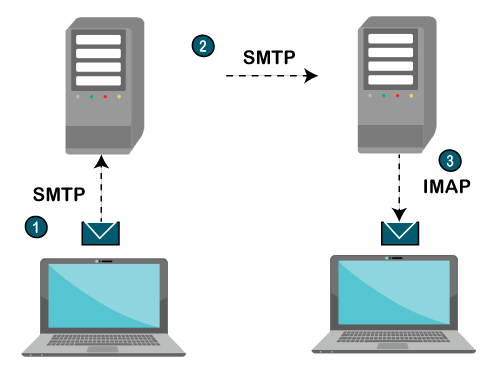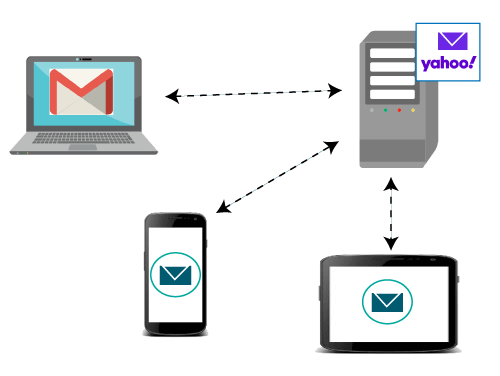IMAP ProtocolIMAP stands for Internet Message Access Protocol. It is an application layer protocol which is used to receive the emails from the mail server. It is the most commonly used protocols like POP3 for retrieving the emails. It also follows the client/server model. On one side, we have an IMAP client, which is a process running on a computer. On the other side, we have an IMAP server, which is also a process running on another computer. Both computers are connected through a network.  The IMAP protocol resides on the TCP/IP transport layer which means that it implicitly uses the reliability of the protocol. Once the TCP connection is established between the IMAP client and IMAP server, the IMAP server listens to the port 143 by default, but this port number can also be changed. By default, there are two ports used by IMAP:
Why should we use IMAP instead of POP3 protocol?POP3 is becoming the most popular protocol for accessing the TCP/IP mailboxes. It implements the offline mail access model, which means that the mails are retrieved from the mail server on the local machine, and then deleted from the mail server. Nowadays, millions of users use the POP3 protocol to access the incoming mails. Due to the offline mail access model, it cannot be used as much. The online model we would prefer in the ideal world. In the online model, we need to be connected to the internet always. The biggest problem with the offline access using POP3 is that the mails are permanently removed from the server, so multiple computers cannot access the mails. The solution to this problem is to store the mails at the remote server rather than on the local server. The POP3 also faces another issue, i.e., data security and safety. The solution to this problem is to use the disconnected access model, which provides the benefits of both online and offline access. In the disconnected access model, the user can retrieve the mail for local use as in the POP3 protocol, and the user does not need to be connected to the internet continuously. However, the changes made to the mailboxes are synchronized between the client and the server. The mail remains on the server so different applications in the future can access it. When developers recognized these benefits, they made some attempts to implement the disconnected access model. This is implemented by using the POP3 commands that provide the option to leave the mails on the server. This works, but only to a limited extent, for example, keeping track of which messages are new or old become an issue when both are retrieved and left on the server. So, the POP3 lacks some features which are required for the proper disconnected access model. In the mid-1980s, the development began at Stanford University on a new protocol that would provide a more capable way of accessing the user mailboxes. The result was the development of the interactive mail access protocol, which was later renamed as Internet Message Access Protocol. IMAP History and StandardsThe first version of IMAP was formally documented as an internet standard was IMAP version 2, and in RFC 1064, and was published in July 1988. It was updated in RFC 1176, August 1990, retaining the same version. So they created a new document of version 3 known as IMAP3. In RFC 1203, which was published in February 1991. However, IMAP3 was never accepted by the market place, so people kept using IMAP2. The extension to the protocol was later created called IMAPbis, which added support for Multipurpose Internet Mail Extensions (MIME) to IMAP. This was a very important development due to the usefulness of MIME. Despite this, IMAPbis was never published as an RFC. This may be due to the problems associated with the IMAP3. In December 1994, IMAP version 4, i.e., IMAP4 was published in two RFCs, i.e., RFC 1730 describing the main protocol and RFC 1731 describing the authentication mechanism for IMAP 4. IMAP 4 is the current version of IMAP, which is widely used today. It continues to be refined, and its latest version is actually known as IMAP4rev1 and is defined in RFC 2060. It is most recently updated in RFC 3501. IMAP FeaturesIMAP was designed for a specific purpose that provides a more flexible way of how the user accesses the mailbox. It can operate in any of the three modes, i.e., online, offline, and disconnected mode. Out of these, offline and disconnected modes are of interest to most users of the protocol. The following are the features of an IMAP protocol:
IMAP General Operation
Let's understand the IMAP protocol through a simple example.  The IMAP protocol synchronizes all the devices with the main server. Let's suppose we have three devices desktop, mobile, and laptop as shown in the above figure. If all these devices are accessing the same mailbox, then it will be synchronized with all the devices. Here, synchronization means that when mail is opened by one device, then it will be marked as opened in all the other devices, if we delete the mail, then the mail will also be deleted from all the other devices. So, we have synchronization between all the devices. In IMAP, we can see all the folders like spam, inbox, sent, etc. We can also create our own folder known as a custom folder that will be visible in all the other devices. Next TopicPOP Protocol |